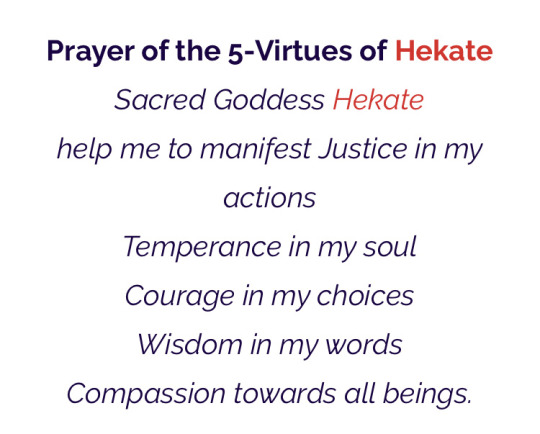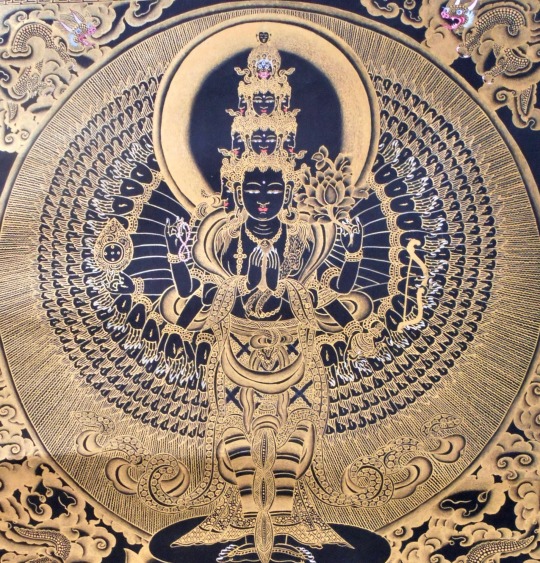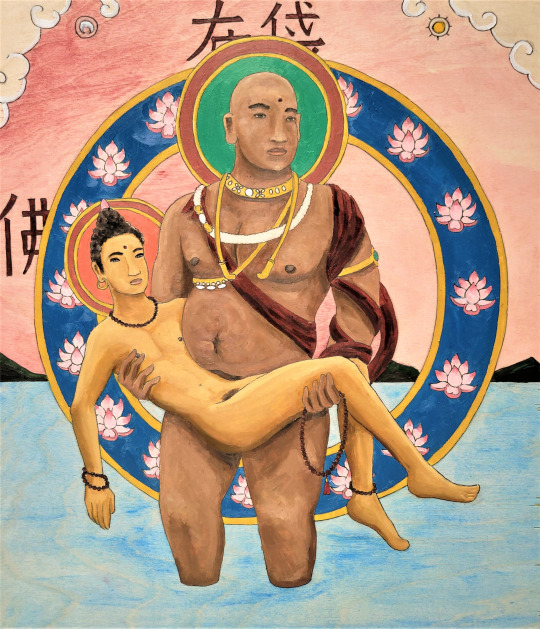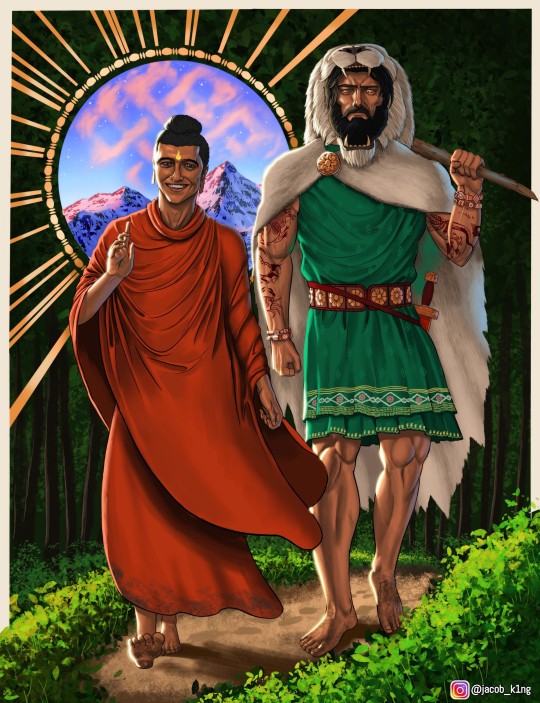#greco buddhism
Explore tagged Tumblr posts
Text
youtube
The Ancient Greeks Who Converted to Buddhism
Greece is very far away from the heartland of early Buddhism in India and parts of Afghanistan and Pakistan. But thanks to Alexander the Great, Hellenistic and Buddhist cultures came into contact in the 4th century BCE, creating a cultural synthesis known as Greco-Buddhism.
#religion#philosophy#ancient religion#hellenic#buddhism#greco buddhism#religion for breakfast#video#divinum-pacis
30 notes
·
View notes
Text






I’ve just been thinking a lot about cycles recently. As a devotee of Hekate and as a member of the Covenant of Hekate, I try my best every day to follow the 5 Virtues.
But today it just struck me how similar the 5 Virtues are to the 5 Mindfulness Trainings of Tibetan Zen Buddhist monk Thich Nhat Hanh.
I was first introduced to Thay when I was 16 and in the deepest depression of my life. His teachings on Zen Buddhism helped me so much, and I feel, led me to Hekate in my spiritual journey now in my 30’s.
The stropholos and the Wheel of Dharma just resonate to me in a complimentary way. And the Ancient Greeks did have a similar stance on reincarnation to Buddhism at least through a few mystery cults. I know that they are not perfectly parallel or syncretic, but I think the boddhisatva Avalokiteshvara and goddess Hekate are a good balance to each other.
We do know that there was cross-cultural blending through the representation of Greco-Buddhist art primarily in Gandhara (parts of modern day Pakistan and Afghanistan).
I was wondering if there are any others here who also follow an eclectic spiritual path?
11 notes
·
View notes
Text
Buddhist Prayer for Strength against Illness
In the shadow of illness, under the weight of pain, May the light of the Dharma guide my way. As I traverse the path of sickness and health, May I find refuge in the Buddha, the Dharma, and the Sangha. In every moment of discomfort, in every pang of distress, May the teachings of impermanence remind me: All things arise and all things pass, And in this knowledge, may I find solace and strength. May the boundless compassion of Avalokiteśvara, the Bodhisattva of Mercy, Envelop me in warmth, easing my suffering and fear. With each breath, may I draw upon the energy of countless Buddhas, Rekindling my spirit, revitalizing my body. Though illness touches me, it is not all of me. Within, there lies a core untouched – luminous, calm, and pure. As I navigate the trials of this life, May I remain connected to this inner refuge, my true nature. For all beings who suffer, for all touched by illness, May we support each other, bear witness to each other's journey. Together, may we walk the Eightfold Path, Finding peace, healing, and liberation in its embrace.
#buddhism#dharma#meditation#personal#greco buddhism#I suck at ryhmes XD#I did my best on this one#I am very tired -_-
9 notes
·
View notes
Photo

Shaka Bosatsu (Sakyamuni Bodhisattva), 2nd-3rd century
Gandhara
Crystalline schist
Total height: 138.0 cm; height of the statue: 114.0 cm
This standing statue of Sakyamuni Bodhisattva whose eyes somewhat lowered wears a crown over the turban. He raises his right hand in front of his chest in the abhaya mudra (a hand position to bestow fearlessness and bring about a sense of calm), while placing his left hand on his waist.
The kneeling figure engraved on the crown front holds a floral garland. The Bodhisattva wears various accessories such as earrings, necklaces, breast ornament, armlets and wristlets. His lower body is covered by a skirt-like garment and his feet are in sandals. His body weight is mostly supported by the engaged left leg while the right side is the free leg. This standing statue has features unique to Gandhara such as the crown over the turban, the right hand in the abhaya mudra and the left hand on the waist.
This is one of the few known Sakyamuni Bodhisattva statues. Even among them, this statue has an exceptionally high artistic value. After the death of Gautama Siddhartha, prince of the Shakya clan, who lived during the 5th or 4th century B.C.E., his followers symbolized him in various forms such as the podium, awning, dharmachakra, and pipal tree under which he attained enlightenment. Early Buddhists did not create a statue of the Buddha until the 1st century C.E., when the statues of Buddha began to appear concurrently in Gandhara (northwestern Pakistan) and Mathura (northern India). This statue shows that Gandhara works feature Western-style realistic expressions, which attest to the strong influence of the Greek and Roman arts. In Gandhara, stone statues of Buddha reached their highpoint between the 1st and 3rd century C.E.
The material crystalline schist is a metamorphic rock which tends to break into layers and is difficult to cut out a thick layer. Accordingly, the right hand and toes of this work are made of other piece of the same material and fixed to the body with iron clamps.
Collection of the Kyushu National Museum
#sculpture#Gandhara#greco buddhism#stone#schist#2nd century#3rd century#art#art history#cultural amalgam#bodhisattva#Shakyamuni#Kyushu National Museum#religion#figure
14 notes
·
View notes
Note
hello ! i was just passing through and wanted to say your blog has been such a nice and insightful read. im an orphic-leaning polytheist and so i find the similarities between certain buddhist teachings and what we know of orphic teachings and cosmology to be very intriguing to say the least. i hope you’re having a wonderful day, thank you for the insight :-)
Thank you for the kind words 💚
From what I know, the earliest traces of Orphism date back to around 5th century BC. Around that time we also have records of Greco-Buddhist syncretism in Gandhara. Perhaps it's not too much of a stretch to consider that the Orphic Mysteries did indeed take some inspiration from Buddhist belief? I was especially thrilled when I read about this, as my path seems to have very much become a marriage of Buddhist belief and Hekatean devotion !
3 notes
·
View notes
Text

16 notes
·
View notes
Photo

Buddha and Budai are Bodhi Buddies - portrait of Reclining Buddha and Laughing Buddha in La Pietà (Lamentation of Christ) pose
https://www.inprnt.com/gallery/eirikswood/buddha-and-budai-are-bodhi-buddies/
4 notes
·
View notes
Text
King Menander (Mένανδρος) is also the interlocutor and questioner of the sage monk Nagasena in the masterpiece of Buddhist literature Milinda Panha (The Questions of Milinda -Menander-, between 100 BC and 200 AD). From the available evidence it seems very plausible that Menander was converted to Buddhism or at least that he was much influenced by Buddhism.

The "Shinkot casket," a container made for Buddhist relics dating to the second century BCE. The casket is of special importance because its inscription mentions Maharaja Minadra -- almost certainly a reference to King Menander, a Greek ruler who controlled parts of modern Afghanistan and Pakistan in the wake of Alexander the Great's conquests.
{WHF} {Ko-Fi} {Medium}
159 notes
·
View notes
Text
Sigh
For the last fucking time, THE JEDI ARE NOT CATHOLIC!
They're not based off of the catholic church, that's just people's fanon interpretation (and it's mostly just people projecting their issues with catholicism onto the Jedi), if you actually take a minute to look up what George Lucas' sources and inspirations for the Jedi, you'll find that he based them off of everything EXCEPT christianity, the inspirations for the Jedi being Japanese and East Asian cultures, Arabic ideas (Jedi may be derived from "Al-Jeddi" which means "Master of the Mystic-Warrior way"), Buddhism, Jewish Mysticism, Samurai Bushido, Shaolin Monks, Hinduism, Qigong, Greco-Roman philosophy and mythology, Sufism, Confucianism, Shinto, and Taoism, the only christianity you might be able to say influenced the Jedi is Methodism, since Lucas was a Buddhist-Methodist
Like yes, you can certainly find Jedi beliefs and practices to be similar or parallel to catholicism and Christianity, I have, but that's on you, that's YOUR interpretation
#i say this as a catholic#wooloo-writes#wooloo writes#star wars#sw#pro jedi#in defense of the jedi#catholicism#jedi#christainity is like the only thing that DIDN’T inspire lucas when he was creating the Jedi#samurai#bushido#shinto#taoism#qigong#shaolin#sufism#greek philosophy#greek mythology#confucianism#jewish mysticism#arabic#jedi and judaism#look i get it#you were traumatized by the catholic church#that sucks#BUT STOP TREATING EVERY RELIGION LIKE THEY'RE CHRISTIANITY
489 notes
·
View notes
Text
ok so like. if you go with me, that there are basically "three written intellectual traditions", the greco-abrahamic, the indosphere, and the sinosphere (with the sinosphere and indosphere shading into each other somewhat, but having little enough contact outside the transmission of buddhism that theyre meaningfully distinct when considered as "traditions"), then its kind of interesting to compare them, obviously. and like, from the perspective of the mediterranean tradition, i think the chinese tradition is way more alien? in particular, the mediterranean and indian traditions care a LOT about god, and like, obviously china HAS gods. but its philosophers dont seem to care that much about god. its cool, and interesting!
52 notes
·
View notes
Text

Heracles and the Buddha
This is based on the fascinating fusion of cultures after Alexander the Great invaded India, otherwise known as Indo-Greek or Greco-Buddhism. In Gandharan sculpture, Heracles is depicted alongside the Buddha as Vajrapani, the Buddha's protector. The pairing of two figures so iconic in their mythologies seemed perfect material for art. The Buddha would help Heracles with anger management, while Heracles would help with clobbering evildoers. Business as usual.
#heracles#hercules#herakles#buddha#buddhism#zen#dharma#ancient greece#ancient india#indo-greek#vajrapani#greek mythology#greek myth art#classical mythology#the buddha#tagamemnon#art#illustration#mythology#buddhist#alexander the great#ancient history
381 notes
·
View notes
Text

Plant Symbolisms 🌱🌿🪴
Flora have a special corner in literature.
Starting from the Greco-Roman period when certain plants were representative of gods (like olive trees for Athena), plants have meant more than just a source of food or pleasure.
Lotus - Symbol of creation, rebirth, and the sun. The blue lotus represents spiritual enlightenment, while the white lotus symbolizes purity.
Papyrus - Represents prosperity, growth, and regeneration, often associated with the Nile River and the goddess Isis.
Mandrake - Associated with love, fertility, and aphrodisiac properties.
Poppy - Symbol of sleep, healing, and regeneration, often associated with the god of sleep, Hypnos.
Rose - Represents love, beauty, and the goddess Aphrodite.
Jasmine - Symbol of sensuality, love, and spiritual growth.
Palm - Represents victory, triumph, and eternal life, often associated with the god Osiris.
Acacia - Symbolizes resurrection and the afterlife, linked to the god Osiris and the Tree of Life.
Cornflower - Represents fertility, abundance, and regeneration.
Anemone - Symbol of protection, healing, and renewal.
Anemone, garden: Forsaken.
Almond, flowering: Hope.
Balm: Sympathy.
Bamboo: The emblem of Buddha. The seven-knotted bamboo denotes the seven degrees of initiation and invocation in Buddhism.
Bay leaf: I change but in death.
Bell flower, white: Gratitude.
Bluebell: Constancy.
Broken flower: A life terminated, mortality.
Buttercup: Cheerfulness.
Calla lily: Symbolises marriage.
Campanula: Gratitude.
Carnation, red: Beauty always new
Chrysanthemum: I love.
Clover, white: Think of me.
Clover, four-leaved: Be mine.
Cinquefoil: maternal affection, beloved daughter.
Convolvulus, major: Extinguished hopes or eternal sleep.
Coreopsis, Arkansa: Love at first sight.
Crocus: Youthful gladness.
Cuckoo Pint: Ardour.
Cypress tree: Designates hope.
Daffodil: Death of youth, desire, art, grace, beauty, deep regard.
Daisy: Innocence of child, Jesus the Infant, youth, the Son righteousness, gentleness, purity of thought.
Daisy, garden: I share your sentiment.
Dead leaves: Sadness, melancholy.
Dogwood: Christianity, divine sacrifice, triumph of eternal life, resurrection.
Fern: Sincerity, sorrow.
Figs, Pineapples: Prosperity, eternal life.
Fleur-de-lis: Flame, passion, ardour, mother.
Flower: frailty of life.
Forget-me-not: Remembrance / true love.
Furze or Gorse: Enduring affection.
Grapes: represent Christ.
Grapes and leaves: Christian faith.
Harebell: Grief.
Hawthorn: Hope, merriness, springtime.
Heartsease or Pansy: I am always thinking of you.
Holly: Foresight.
Honeysuckle: Bonds of love, generosity and devoted affection.
Honesty: Sincerity.
Ivy: Memory, immortality, friendship, fidelity, faithfulness, undying affection, eternal life, marriage.
Jonquil: “I hope for a return of affection.”
Lalla: Beauty, marriage.
Laurel leaves: Special achievement, distinction, success, triumph.
Marigold: Grief or despair.
Morning glory: Resurrection, mourning, youth, farewell, brevity of life, departure, mortality.
Mystic rose: Mother.
*some of these flower symbols have Greek or Roman origins but were also used in ancient Egyptian culture.
If you like my blog, buy me a coffee☕ and find me on instagram! 📸
🖱️References
https://www.proflowers.com/blog/plant-symbolism-guide
https://www.pinterest.com/pin/396668679699365428/
https://lilysflorist.com/blog/the-symbolism-of-flowers-in-literature-and-poetry-a-look-at-the-hidden-meanings-of-blooms-in-classic-texts/#:~:text=Rose%20%2D%20Represents%20love%2C%20beauty%2C,and%20the%20Tree%20of%20Life.
#writer#writers#creative writing#writing#writing community#writers of tumblr#creative writers#writing inspiration#writeblr#writing tips#writers corner#writers community#poets and writers#writing advice#writing resources#writers on tumblr#writers and poets#helping writers#writing help#writing tips and tricks#how to write#writing life#let's write#resources for writers#references for writers#writer stuff#on writing#flower symbolism#symbols#flower meanings
190 notes
·
View notes
Text
Depending on what pantheon/mythology you’re looking at if you claim your goal is to kill a god there will be varying degrees of probability and possibility for you.
The things we’re worshipping is kind of the earth and animals and people themselves of course they die (various forms of animism and ancestor worship)
Dying is kind of a promotion in this religion if you’re important enough (some types of Buddhism, Catholicism from certain points of view)
Technically possible to kill a god and it has happened before but you probably won’t be the one to do it (Egyptian, Norse, Aztec, some other polytheistic religions)
Lol and also lmao gods don’t die. You can stab them though. (Greco-Roman mythology)
God(s) became mortal on purpose you’re not special L + Ratio this was part of the plan the whole time (Christianity, some avatar stories in Hinduism)
What are you gonna do? Stab the entire universe? You’re picking a fight with reality itself. Idiot. (Most monotheistic religions)
339 notes
·
View notes
Text


My newly cleaned and sorted devotional space, plus a picture with a slight filter put over it.
#hellenic polytheism#hellenic pagan#hellenism#theoi#aphrodite#hellenismos#budai#altar#greco-buddhism
14 notes
·
View notes
Text
Nothing quite like the feeling of knowing a new used obscure book is on its way
thriftbooks my best friend thriftbooks…….
23 notes
·
View notes
Text
i eventually talk more about first names here, but now i'm doing something else hahaha.
The Turkish word fener in turn comes from Greek phanarion (φανάριον), a diminutive of phanos (φανός), torch, which came to mean “beacon” or “lighthouse”.

(from here)
aww... with all the subtle ("subtle") arabic influence implied in the world of escaflowne (spanish, portuguese, italian, mughal india, etc. etc.) i kinda like the idea that they merged a greek origin (atlantis) with an arab one, given the extensive relationship between greece and MENA and beyond in real history.
for example... greco-buddhist art or Gandhara art began with alexander the great's arrival in india. Gandhara was an indo-aryan civilisation in modern pakistan and afghanistan, and a central location for the spread of Buddhism to Central Asia and East Asia.
see also: the indo-greek Yavana kingdom in afghanistan, pakistan, and northern india. the capital was modern-day bagram, which was situated in a VERY important passage on the silk road. (again... basra? bagram? basram, perhaps?) the name of the town back then though was "Alexandria of the Caucasus Indicus," to mirror the "western" equivalent, the Caucasus Mountains. as a result of his spread, stories of alexander the great made their way into persian traditions, central asian traditions, malaysian traditions, arab traditions including muslim spanish (andalusian) traditions... etc.
anyway. check this out:

right?! you'd look at this and think it was straight up greek, right? this is buddha and a bodhisattva (or possibly gilgamesh— he was linked to buddha in a number of greco-indian works of art.)
but! let's go back to fener/phanarion.
Phanariots, Phanariotes, or Fanariots (Φαναριώτες, Fanarioți, Fenerliler) were members of prominent greek families in Phanar (Φανάρι, modern Fener.) additionally, these families made up the majority of dragomans (haha, it just means translator/interpreter) who had to be knowledgeable in arabic, persian, turkish, and european languages. they were mainly ottoman greek because greek trading communities did substantial international business from the mediterranean sea, black sea, atlantic ocean, and indian ocean. other peoples with strong international links, notably armenians, were also recruited for the job. anyway, the word/meaning spread to a number of languages


(link)
it all comes from the proto-indo-european root meaning "shine." phānárĭon is specifically a diminutive of "fanari" (φανάρι) which is plural for lights. being a diminutive, this gives it a sense of smallness... a tiny light. other variants are φαναριού (fanarioú) or φαναρίου (fanaríou— the differences seem subtle i know) but one which might sound more familiar is φανάρια, pronounced /faˈna.ri.a/
i mean, who knows! but what if? i haven't been able to find too much of anything conclusive (but also, the film does remove family names entirely it seems, so i'm not even sure how much it matters. but i love the fun of it.)
7 notes
·
View notes